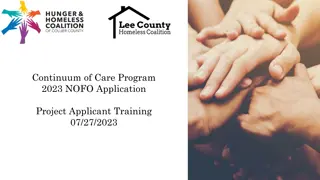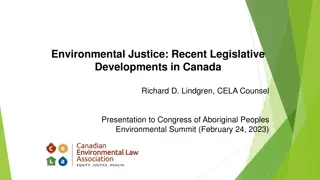HUD's Environmental Justice Strategy Update Overview
HUD's Environmental Justice Strategy Update outlines the agency's commitment to addressing environmental justice concerns and enhancing access to environmental benefits through policies, programs, and activities. The strategy includes collaboration with federal partners, stakeholder engagement, and a new Switchboard page for public input. It is part of a broader effort to protect communities from environmental and health hazards, with a focus on transparency and public participation in Community Development Block Grant processes.
Download Presentation

Please find below an Image/Link to download the presentation.
The content on the website is provided AS IS for your information and personal use only. It may not be sold, licensed, or shared on other websites without obtaining consent from the author.If you encounter any issues during the download, it is possible that the publisher has removed the file from their server.
You are allowed to download the files provided on this website for personal or commercial use, subject to the condition that they are used lawfully. All files are the property of their respective owners.
The content on the website is provided AS IS for your information and personal use only. It may not be sold, licensed, or shared on other websites without obtaining consent from the author.
E N D
Presentation Transcript
Intermountain Fair Housing Council, Inc. The work that provided the basis for this presentation was supported by funding under a grant with the U.S. Department of Housing and Urban Development. The creator is solely responsible for the accuracy of the statements and interpretations contained in this presentation. Such interpretations do not necessarily reflect the views of the federal government.
HUDs Environmental Justice Strategy Update is found at: HUD s Environmental Justice Strategy Update is found at: http://portal.hud.gov/hudportal/documents/huddoc? id=HUDEnvJustStratUBF.pdf In April 2012, HUD published its 2012-2015 Departmental Environmental Justice Strategy. HUD is committed to meeting the goals of Executive Order 12898, "Federal Actions to Address Environmental Justice in Minority Populations and Low-Income Populations," which states that each federal agency, with the law as its guide, should make environmental justice part of its mission. 2 10/1/2024
HUD has developed its Environmental Justice Strategy (EJ Strategy) which is a four-year plan to address environmental justice concerns and increase access to environmental benefits through HUD policies, programs, and activities. 3 10/1/2024
HUD will continue to work with the Inter- Agency Working Group and other federal partners to engage stakeholders through outreach, education, and stakeholder events and respond to public comments through its annual implementation reports. 4 10/1/2024
HUD has also launched a new Switchboard page to allow the public to provide input into the process. Switchboard is an interactive website for ideas, feedback, and crowdsourcing. An EJ Strategy update is at: http://switchboard.uservoice.com/forums/31 2703-enviromental-justice-strategy. 5 10/1/2024
The release of HUD's EJ Strategy is part of the latest step in a larger Administration-wide effort to ensure strong protection from environmental and health hazards for all community members. HUD is developing a clear, easily accessible process to get assistance and or raise EJ complaints with HUD. 6 10/1/2024
Greater inclusion and transparency in public participation in Community Development Block Grant process. Greater inclusion and transparency in the fair housing planning process. Grant funds and community/public participation in EJ strategies. 7 10/1/2024
Siting housing developments in locations free of environmental hazards and in high economic opportunity areas do residents have access to healthy, affordable food, public transit, healthcare facilities, quality educational institutions, income/jobs, etc. Addressing gentrification, disaster-related displacement, and right-of-return in HUD- assisted housing. 8 10/1/2024
Connecting rural communities to HUD funding and discretionary programs. Accessing broadband internet. Preventing linguistic isolation and addressing literacy levels of residents to meet EJ needs. 9 10/1/2024
Comprehensive neighborhood revitalization with respect to crime and violence prevention strategies. Comprehensive neighborhood revitalization with respect to crime and violence prevention strategies. See the Choice Neighborhoods Initiative. http://www.hud.gov/cn. See the Choice Neighborhoods Initiative. 10 10/1/2024
The Choice Neighborhood promotes: The Choice Neighborhood promotes: Revitalization, Revitalization, Sustainability (Green Building practices), Sustainability (Green Building practices), Livability (reducing crime and violence), and Livability (reducing crime and violence), and Accessibility Including universal design inherently accessible to older people, people without disabilities, and people with disabilities, and Including visitability or ease of access for persons with disabilities. Accessibility Including universal design-- inherently accessible to older people, people without disabilities, and people with disabilities, and Including visitability or ease of access for persons with disabilities. --meaning that the design is meaning that the design is 11 10/1/2024
Use of green building efforts in HUD-assisted Housing reaching low-income and other vulnerable communities to address affordable housing, reduce air pollution, conserve natural resources, improve public health, and increase emergency preparedness. 12 10/1/2024
Address healthy homes issues including lead, structural integrity, material composition, radon mitigation, indoor air and water quality, presence of pests and chemical exposure including smoke homes must be dry, clean, pest-free, contaminant-free, safe, well-ventilated, well- maintained, and thermally-controlled. Address the connection between the home and the community with regard to design elements. 13 10/1/2024
Considering Environmental Justice issues in the site selection of housing helps the community and entitlement jurisdictions meet its obligation under the Fair Housing Act to affirmatively further fair housing or address barriers to fair housing choice. 14 10/1/2024
Some concerns raised regarding EJ and the QAP: Look at what extent the QAPs contain selection criteria aimed at expanding housing choice and increasing the supply of open housing and fostering more inclusive communities. Examine whether the QAP incorporates criteria to ensure that LIHTC siting decisions do not increase or perpetuate residential segregation in low opportunity areas. Examine whether the QAPs enable you to meet your legal obligation to affirmatively further fair housing. Does the LIHTC program exacerbate poverty concentration and racial segregation because they are sited in areas with high number of minorities and or impoverished neighborhoods/low economic opportunity areas. 15 10/1/2024
Some concerns raised regarding EJ and the QAP: Does QAP scoring expand housing choice, increase the supply of open housing, foster inclusive communities, ensure LIHTC complexes are sited in high economic opportunity areas that are not increasing and or perpetuating residential segregation with environmental hazards. QAP programs should proactively identify and eliminate barriers to developing tax credit housing for families in low-poverty areas so they have housing choice in high economic opportunity areas, and that the program provide incentives to promote development of mixed-income housing that includes both affordable and market-rate units. These corrective steps help produce a more balanced distribution of affordable housing units throughout the area and in various regions of the State. You will want to monitor whether the tax credit allocation data shows that it is addressing barriers to housing choice for diversity using demographic and occupancy information, marketing and design and construction review. 16 10/1/2024
Some concerns raised regarding EJ and the QAP: Housing or housing plans that exclude families with children may be a fair housing barrier; Because of NIMBYISM, developers are deterred and or don t want to build housing for families and favor building senior housing; Development is steering families outside of urban areas, out of high economic opportunity areas, and or centers of downtown does the QAP exacerbate development; and Does the QAP promote development in high economic opportunity areas and housing for families with children as well as other community members. 17 10/1/2024
Requirement 1. An accessible building entrance on an accessible route. Requirement 1. An accessible building entrance on an accessible route. Requirement 2. Accessible public and common use areas. Requirement 2. Accessible public and common use areas. Requirement 3. Usable doors (by a person in a wheelchair/with mobility impairment). Requirement 3. Usable doors (by a person in a wheelchair/with mobility impairment). Requirement 4. Accessible route into and through the dwelling unit Requirement 4. Accessible route into and through the dwelling unit 18 10/1/2024
Requirement 5. Environmental accessible locations. Requirement 5. Environmental controls in accessible locations. controls in Requirement 6. Reinforced walls in bathrooms for later installation of grab bars. Requirement 6. Reinforced walls in bathrooms for later installation of grab bars. Requirement 7. Usable kitchens and bathrooms. Requirement 7. Usable kitchens and bathrooms. 19 10/1/2024
Call Accessibility First toll Resource Center: (888) 341 Call Accessibility First toll- -free Design and Construction Resource Center: (888) 341- -7781 (V/TTY) free Design and Construction 7781 (V/TTY) Additional resources: Additional resources: U.S. Department of Housing and Urban Development (HUD) 1 1- -800 or 1 1- -800 www.hud.gov U.S. Department of Housing and Urban Development (HUD) 800- -669 or 800- -927 www.hud.gov 669- -9777 927- -9275 (TDD) 9777 9275 (TDD) Intermountain Fair Housing Council, Inc. (208) 383 or 1 1- -800 www.ifhcidaho.org Intermountain Fair Housing Council, Inc. (208) 383- -0695 in Boise or 800- -717 www.ifhcidaho.org or 0695 in Boise 717- -0695 (toll 0695 (toll- -free) or contact@ifhcidaho.org free) contact@ifhcidaho.org 20 10/1/2024
U.S. Department of Housing and Urban Development (HUD) 1 1- -800 or 1 1- -800 www.hud.gov U.S. Department of Housing and Urban Development (HUD) 800- -669 or 800- -927 www.hud.gov 669- -9777 927- -9275 (TDD) 9777 9275 (TDD) Intermountain Fair Housing Council, Inc. (208) 383 or 1 1- -800 www.ifhcidaho.org Intermountain Fair Housing Council, Inc. (208) 383- -0695 in Boise or 800- -717 www.ifhcidaho.org or 0695 in Boise 717- -0695 (toll 0695 (toll- -free) or contact@ifhcidaho.org free) contact@ifhcidaho.org 21 10/1/2024























